From Stephen Wolfram's blog - British physicist, mathematician, programmer, writer. He developed the Mathematica computer algebra system and the WolframAlpha knowledge extraction system.The essence of the task

Suppose we can place beacons in our solar system (and beyond) that can survive for several billion years and record all the achievements of our civilization. What should they be?
This question is fairly easy to come up with a superficial and shallow answer. But in fact, it seems to me that this is a deep and, in a sense, unsolvable, philosophical problem associated with such fundamental concepts as knowledge, communication, and meaning.
And yet, a
friend of mine recently
took up this problem seriously - he makes small quartz disks, and wants to scatter them around the solar system with the help of spacecraft. At first, I said that these attempts were in vain, but in the end I nevertheless agreed to be a project adviser, and at least try to decide what we can do about it.
OK, so what's the problem? In essence, it consists in transmitting knowledge or meaning from within our cultural and intellectual context to the outside. To understand that this is difficult, it is enough to recall archeology. Why a few thousand years ago, some stones were built in a certain configuration? Sometimes we can answer this question because it turns out to be close to our modern culture. But most of the time it is very difficult to say.
Well, what could be the potential uses for these beacons? One of them is to create a safety copy of human knowledge so that everything can be started over again, even if something goes completely wrong with our earthly civilization. And, of course, from a historical point of view, we are very fortunate that we have preserved ancient texts when a cultural restart took place in Europe during the Renaissance. But this was partially possible due to the continuous tradition of languages - such as Latin and Greek - not to mention the fact that people were both creators and consumers of the material.
But what if the consumers of the lighthouses that we plan to distribute in the solar system, will be aliens, historically unrelated to us? Then this problem becomes much more complicated.
In the past, when people thought about it, they had a tendency to say “just show them mathematics: it is universal, and it will impress them!” But it seems to me that in fact both of these statements about mathematics are not true.
To understand this, we need to delve into the fundamentals of science, on which I, by the will of fate, worked for many years. The reason why people consider mathematics as a candidate for a universal language of communication is because its designs look accurate, and at least here, on Earth, there is only one version of it, so it seems that it can be defined without cultural references. . But if you really start to think up how to transfer information about mathematics without any assumptions (as I did,
advising the authors of the movie “Arrival” ), it will quickly become clear that it is necessary to go down to the level “below mathematics” in order to get computational processes with more simple rules.
And one of the obvious conclusions (as is often the case, at least with me) is the use of
cellular automata . It is easy to demonstrate complex drawing, created by simple and well-defined rules.

But there is a problem: there are many physical systems that work according to similar rules and produce equally complex patterns. Therefore, if such an approach should demonstrate the impressive achievements of our civilization, it cannot cope with this.
Okay, but there must be something that we can show, and from what clearly follows the presence of a spark of intelligence? Personally, I have always assumed that it is. But one of the consequences of the foundations of science, which I was engaged in, is, as I called it, the "
principle of computational equivalence ." He argues that after any system rises above the most primitive level, it will exhibit behavior equivalent in complexity to the computational process.
Therefore, although we are proud of our brains, and our computers, and our mathematics, they, in fact, will not be able to give out anything beyond what simple programs like cellular automata can issue - or, for that matter, natural physical systems . Therefore, when someone says that “the weather is mental”, it’s not so stupid: unstable dynamic processes that lead to weather are computationally equivalent to processes, for example, those taking place in our brain.
At this place, the natural human impulse will declare that we, and all that we have achieved as a civilization, should stand out with something. People can say, for example, that the weather has neither a meaning nor a purpose. Of course, we can attribute these goals to her (“she is trying to equalize temperatures between two points”), and without some cultural history there is no meaningful way to talk about whether they really are or not.
Well, if the demonstration of complex calculations does not convey the uniqueness of us and our civilization, what can it convey? The answer is in the details. Complex calculations are common in the universe. Our peculiarity lies in the details of our history and what we think is valuable.
We recognize this by observing the progress of artificial intelligence. We manage to automate more and more things that people are capable of - even reasoning, judgment, creativity. But what we by definition cannot automate is the process of choosing what we want and what our goals are. After all, they are closely connected with the details of our biological existence and the history of our civilization - and this is what distinguishes us.
Well, how can we convey such things? Well, it's hard. Because, naturally, they are tied to our particular aspects, and these aspects may not necessarily be conveyed in the way we are trying to establish communication.
As a result, we still have a project that plans to launch lighthouses by spacecraft. So what is the best place to put on them? I spent a significant part of my life creating what the Wolfram Language is today, and the goal of which is to provide an accurate language for transmitting the knowledge accumulated by our civilization so that it is understandable to both people and computers. Perhaps this project, and my experience with it, can help. But first you need to talk about history in order to understand what worked in the past and what did not.
Lessons of the past
Several years ago I was in a museum and considered the
wooden models of the life of ancient Egypt, buried with some kind of ruler several thousand years ago. How sad, I thought. - They thought it would help them in the afterlife. But it did not work - they just ended up in a museum. ” And then it suddenly dawned on me: “No, it worked! This is their afterlife! ”They successfully transferred some essence of their life to a world far beyond their world.

Naturally, when we look at these models, it helps us that many of their features are familiar to us in our time. Cows Boat with oars. Scrolls. But something is not so familiar. What are these weird stuff at the ends of the boats? What is their purpose? What are they used for? And here begins the difficult task - to try to understand it without a general context.
Last summer I visited the archaeological excavations in Peru in the town of
Caral , where a lot of all sorts of buildings built more than 4000 years ago were found. It was pretty obvious what some of them are for. And the purpose of others was difficult to understand. And I kept asking the guide questions. And almost always the answer was the same: “for ceremonial needs.”
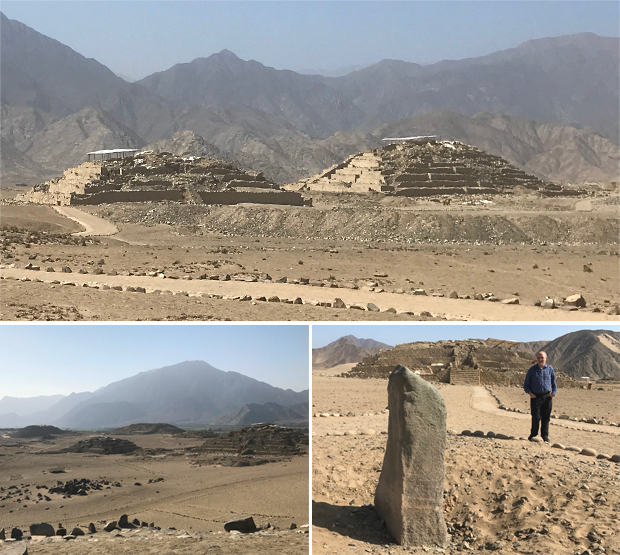
I immediately began to reflect on modern buildings. Yes, we have monuments and works of art. But there are skyscrapers, stadiums, cathedrals, canals, road junctions and much more. And people are used to interact almost ritually with these buildings. But in the context of modern society, we would not call them “ceremonial”: from our point of view, each type of building has a definite goal, which we can describe. But this description inevitably includes a rather deep cultural context.
When I grew up in England, I often walked in the woods near the house - and found all sorts of holes, berms and other traces of work with the land. I asked people what it is. Some said that these were ancient defenses; some thought that the pits were the funnels from the bombs of the Second World War. Who knows - maybe they have arisen because of the process of erosion, not associated with people.
Almost 50 years ago, as a child and relaxing in Sicily, I found this item on the beach:
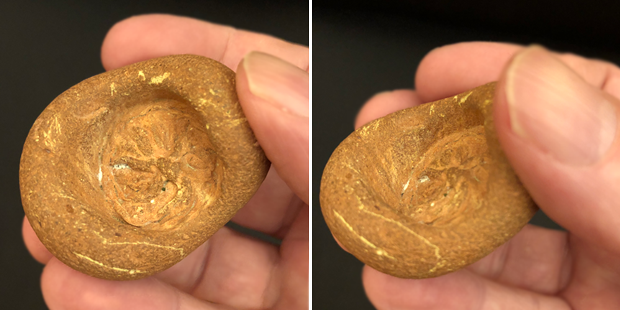
Very interested in what it is, I took it to my local archeology museum. “You did not come there, young man,” they told me, “this is obviously an object of natural origin.” So I went to the museum of natural history, only to hear: “Sorry, this is not for us; it's an artifact. ” And since then, this mystery has remained unsolved (although with the help of modern methods of analyzing the material it can be solved - and I probably should do it!)
In many cases, it is difficult to say whether the artifact is or not. Take the buildings that we built on Earth. When I was writing the book “A New Type of Science,” I asked astronauts the question of which structure they noticed from space had the most obvious human origin. It was not the Great Wall of China (which is really hard to see from space). No, they said that it was a stretch of road crossing the Great Salt Lake in Utah (the 50-kilometer railroad, built in 1959, on different sides of which the algae have a different color).

There was also a circle with a diameter of 20 km in New Zealand, a circle with a diameter of 50 km in Mauritania and a 65 km circle in Quebec (a bit like the heptapod from Arrival):

Which ones are artifacts? It was before the appearance of the web, so we had to get in touch with people and find out this question. A New Zealand government researcher said that we did not think that this circle follows the shape of a conical volcano in the center. “In fact, everything is much more prosaic,” he said, “this is the border of the national park, where trees are pruned only outside, that is, it is an artifact. Other circles are not about people. ”
Quite interesting to look for evidence of people visible from space. Such as the grid of lights of Kansas or the lines of lights in Kazakhstan. In recent years, an image of an 11-kilometer palm tree has been seen in Dubai. On the other hand, people
tried to search for what might have been “archaeological structures” in high resolution photographs of the Moon.
Okay, back to the question of the meaning of things. In the
7000-year-old cave painting, we can recognize animal shapes and
hand prints . But what do the configurations of these drawings mean? At the moment we have no solid ideas about this.

Maybe it will be easier for us if we turn to things that are closer to mathematics. In the 1990s, I hunted for early examples of complex structured drawings around the world. I found a lot of interesting things (for example, the mosaic supposedly made by
Gilgamesh , 3000 BC, and the earliest fractals, from 1210 AD). In most cases, I could determine the rules by which the drawings were made — although I could not say what “meaning” they should convey, or whether they were “just decorations”.
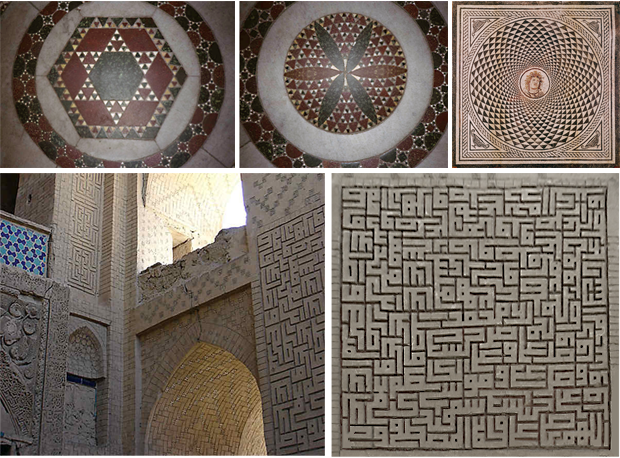
The last ornament puzzled me for a while. Maybe this is a cellular machine XIV century? Or something from number theory? But in the end it turned out that this is the
image of 62 attributes of Allah from the Quran, in a special rectangular form of Arabic calligraphy, constructed as follows:

About 10 years ago I learned about the existence of a
11,000-year-old picture on a wall in Aleppo, Syria (I hope that it was preserved). What is it? Maths? Music? Map? Decoration? Digital data coding? We, in general, do not know.
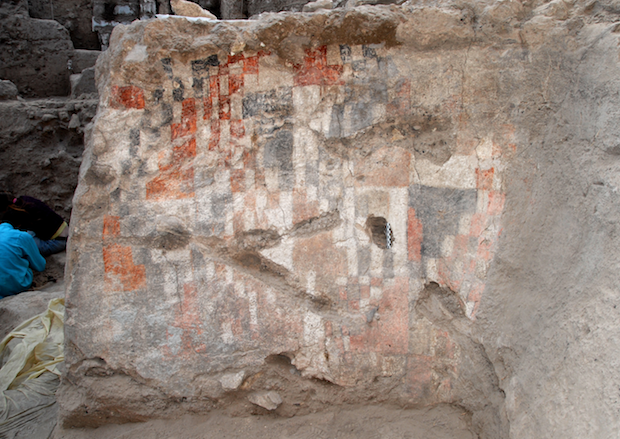
I can continue with examples. Often people say: “if you see this and that, then it is certainly done for some purpose”. The philosopher Immanuel Kant expressed the opinion that if you see
a regular hexagon drawn on the sand , then only a rational reason can be invented for it. I remembered this every time I saw
hexagonal shapes in stones . A few years ago I heard about hexagons in the sand, produced by the work of the wind alone. The largest hexagon I know of is the kind of
storm around Saturn’s north pole - and it probably was not “placed there for any particular purpose” in any ordinary sense of the word.
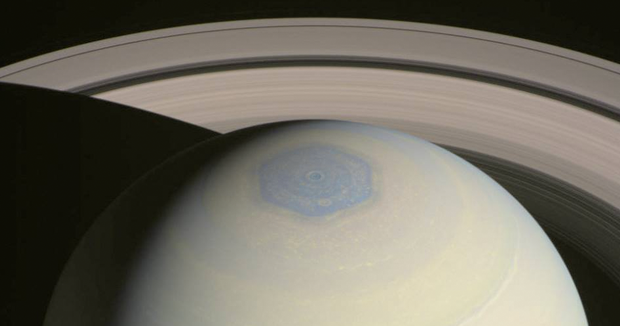
In 1899, Nikola Tesla received many complex and strange-sounding radio signals, often a bit like Morse code. He knew that they were not made by humans, so he immediately decided that these were radio messages from the inhabitants of Mars. Naturally, it is not. It is simply the result of the physical processes occurring on Earth in the ionosphere and magnetosphere.
But here is the irony: they often sound surprisingly similar to the songs of the whales! And, yes, in the songs of whales, there are all sorts of complex rhythmic moments and other features that remind us of languages. But we still do not know whether they are used for communication, or simply for decoration, or for games.
One can imagine that with the help of modern machine learning and enough data it will turn out to train the translator to “communicate with animals”. There is no doubt that it will be easy enough to build questions like “are you happy?” Or “are you hungry?” But what about more complicated things? For example, those that we want to use to communicate with aliens?
I think it will be very difficult. Even despite the fact that animals live in the same environment with us, it is not very clear how they reflect. The fact that even their daily experience of communicating with the world may be very different does not simplify the task - for example, to go with an emphasis on smell, and not on sight, and so on.
Animals, of course, are also capable of producing "artifacts." As, for example, this
pattern in the sand , made in about a week by a small
puffer fish:

But what is it? What does this mean? Can this “iglofakt” be considered a great achievement of the bubble-bell civilization, which should be glorified throughout the solar system?
Someone will say - of course not. Indeed, despite the fact that it looks difficult, and even “artistically” - something like bird chirping, which contains elements of music - you can imagine how one day we will be able to decipher the nerve paths in the brain of puffer fish, forcing it to perform these actions. So what? After all, one day we will be able to sort out the nerve paths of a person, forcing them to build cathedrals - or arrange beacons in the solar system.
Aliens and philosophy of purpose
I have found the following thought experiment useful for a long time. Imagine a very advanced civilization, capable of moving even stars and planets at will. What configuration can they bring them to?
Maybe they would want to make a "beacon of purpose." Or maybe, like Kant, one can decide that this can be done by arranging some easily recognizable geometric configuration. What about an equilateral triangle? No, it will not go.
Trojan asteroids already form an equilateral triangle with Jupiter and the Sun, simply because of physics.
And it soon becomes clear that the aliens can not do anything to "prove the existence of the target." The configuration of the stars in the sky may seem random to us (although we still see constellations in them). But one cannot say that there is such a correct way of viewing, by using which some great goal will be seen in them.
But what is confusing is the fact that in a sense this method exists! Because, simply proceeding from physics, the resulting configuration can be described as achieving the goal of bringing to a limit a certain value determined by equations for matter, gravity, and so on. Of course, we can say that "this does not count, it is just physics." But our entire Universe, and we, too, work according to the laws of physics. Therefore, we return to the discussion of whether there is any sense in such an extremization.
We humans have certain ways to judge if there is any meaning to us. And it comes down to whether we can “tell a story,” explaining in culturally meaningful terms, why we are doing something. Of course, the notion of goal developed along with the development of humanity. Imagine that you are trying to explain the purpose of walking on a treadmill, or buying goods in the virtual world, or sending the same beacons into the solar system, to people who lived thousands of years ago and built those buildings in Peru that I demonstrated earlier.
We are not familiar with the ways of telling "culturally meaningful stories" about stars and planets, except mythology. And in the past we could imagine that the stories told would inevitably be less rich than those that we can tell about our civilization. But here the very fundamentals of science that I was engaged in come into force. The principle of computational equivalence says that it is not so - and what happens to stars and planets is as rich as what happens in our brains or with our civilization.
In an attempt to "show something interesting" of the Universe, we could decide that it is best to provide complex abstract calculations. But it will be useless. Abstract computing in the universe is complete.Instead, the “most interesting” will be the specific and random details of our personal history. Of course, one can imagine that somewhere there is something so complex that it can look at the beginning of our history and immediately figure out how it will develop. But the consequence of the principle of computational equivalence is what I call computational irreducibility — it implies that there are no short cuts in history; to figure out how things developed, you have to live it. This principle helps to feel the meaningfulness of life.The role of language
, , . ? , . , , – . , , , , .
: . , , , , RGB – , 2D, .. , , , . , , , , , .
, , , . , XIII , , , – , .
, (, , ) – , , , .
, , . , .
, , – , , , . , ( ) , .
, , , , , , ( ) – . ,
,
, ( ,
). —
,
,
- ,
,
– .
, , .
– , , - «», , , :

?
, , , , « », . , , , – – . - ?
, . , . , , , , , :

? . : «, , , ». , . , . , – , - .
Suppose we decide to concentrate on traditional mathematics. We will be in the same situation. Perhaps we can offer theorems in some abstract system. But it will be possible to say about each of them: “Okay, well, it follows from these rules — just about how the shapes of molecules determine how they can form a crystal.” And the only way to actually convey some message is the choice of which theorems to show, which axiom system to use. But to interpret this choice will again require a cultural context.One of the places in which the formal approach meets reality is the construction of theoretical models of real things. We have a physical process, and we have its formal symbolic model — made using mathematical equations, programs like cellular automata, or whatever. It may seem to us that this connection instantly determines the interpretation of our formal system. But, again, this does not happen - our model is just a model that describes some properties of the system, and idealizes all the others. And to see how it works, a social context is required.There is one small exception to all this: what if there is a fundamental theory of the physics of everything, which, perhaps, can be described as the simplest program? Then this program is not just an idealized model. But a complete view of physics. And this “truth” about our Universe will describe the physics that governs absolutely all the entities existing in it., , , ; , , «» . , , ( ). . - : ! ( – , , - ?)
Let's move away a little from this level of philosophy. Suppose we deliver a physical object - a spacecraft, for example - to our newcomers. You might decide that the task will then be easier. But again, the problem is the need for a cultural context in order to decide what is important and what is not. Is the message the location of the rivets? Engineering optimization? Engineering traditions? Or is it all random?Practically everything that is on the spacecraft was placed there in the process of creating the spacecraft. Something was placed "specially" by the decision of the engineers. Something was required due to the physics of fabrication. But in the end, a spacecraft is just a spacecraft. You can imagine the re-creation of the nervous processes that took place in human engineers, just as you can imagine the re-creation of thermal currents during thermal processing of products. But thanks to what mechanism was the spacecraft built, what was its purpose - what message did it try to convey?Molecular version
It's one thing to talk about sending messages based on the achievements of our civilization. But what about just sending our DNA? She, of course, does not describe (directly, at least) our intellectual achievements. But it describes a couple of billion years of biological evolution and represents a certain monument to 10 40 organisms that have ever lived on our planet., , « ?» , ( ) , « ». , - « , , » – , , .
, ( )? - , . . ? , , - ?
- , « », .
, . , , , .
, ? , , ? , , , , - , – , , , .
? , – . , « ».
, . , , – , . - , , , , , .
, . , , .
, , , . . , , , , , . .
, , , . , , , , «», . . , , , , .
And I expect that in the future, an ever smaller share of human-created technology will become “recognizable” and “understandable.” An optimized electronic circuit does not necessarily have a beautiful repetitive structure, like optimized algorithms. Naturally, it is sometimes difficult to understand what is happening. This pattern of holes on the speaker is designed to optimize some acoustic moments, or is it just a decoration?And again we come across the same philosophical difficulty: we recognize the mechanics of the work of things, and we can tell a story about why they can work that way. But there is no way to decide whether this story is “true” - except to refer to details related to people and the culture of people.Speaking of peace
Let's go back to the language. What is language really? Structurally (at least, in examples known to us so far) this is a set of primitives (words, grammatical constructions, etc.) that can be assembled according to certain rules. We can study language formally at this level just as we can learn how to assemble a mosaic according to a certain set of rules. But what makes a language useful for communication is that its primitives are somehow connected to the world - and that they are connected with knowledge.
As a first approximation, words or other primitives of a language turn out to be suitable for describing aspects of the world about which we want to communicate. We have different words for the table and the chair, because we find it useful to separate these concepts. We could begin to describe the details of the table legs, but for many purposes it will be enough to say just one word, or to give one symbolic primitive: “table”, describing what we think of as a table.
Of course, in order for the word “table” to be useful for communication, the sender and the recipient of the word must share the understanding of its meaning among themselves. In practice, in natural languages this is usually achieved by a social method - when people see how other people describe such things as the “table”.
How to determine which words should exist? This process is controlled by society, but at some level it is about being able to define concepts that are periodically useful to us. But all these arguments practically do not go beyond the limits of the logical circle. Useful concepts depend on the environment in which we live. If we did not have tables (for example, in the Stone Age), there would be no use for the word “table”.
But when we introduce a new word for something (for example, “blog”), it becomes easier for us to think about it - and these objects in the environment created by us for ourselves, or chosen by us for life, becomes larger.
Imagine a mind that exists in the form of a liquid (say, the weather), or even imagine an aquatic organism, accustomed to a liquid habitat. The set of words that we take as a matter of course, describing solid objects or places, is not particularly useful to him. Instead, he may have words for aspects of fluid flow (say, for stable vortices that change in some special way), which we have never perceived as concepts for which words are needed.
It may seem that other creatures in our physical Universe will necessarily have something in common with us in how they describe the world. But I do not think that this is so - in fact, as a result of such a phenomenon as computational irreducibility.
The problem is that computational irreducibility implies the existence of an infinite number of irreducibly different environments that can be built on the basis of our physical Universe - just like there are an infinite number of irreducibly different universal computers that can be created using any universal computer. In a more practical sense, different creatures - or different minds - can work using irreducibly different “technological collections” based on different elements of the physical world (atomic, electronic, liquid, gravitational, etc.) and different chains of inventions. As a result, their method of describing the world may be irreducible.
Language formation
Well, if we take a certain perception of the world, then how to understand which words or concepts will be useful to describe it? In the case of natural human languages, this description simply develops as a result of a process similar to natural selection in the course of using language by society. And when developing Wolfram Language as a language for computational communication, I used what evolved in human language.
How can you see the appearance of words and concepts in a context more distant from the human language? Nowadays, there is an answer, which is to use an increasingly apparent example of someone else's intelligence: artificial intelligence.
Let's take a neural network and start feeding it, say, images of a pile of things of the world (choosing media in the form of two-dimensional pictures with a certain data coding, we, in fact, define a certain way of "perception of the world"). And let's see what differences the neural network will make when sorting or classifying these images.
In practice, different runs will give different answers. But any pattern of answers will give us an example of language primitives.
This is easy to see when training a network that identifies images. We started doing this several years ago using tens of millions of images divided into 10,000 categories. Interestingly, if you look at the network itself, then, in essence, it deals with the analysis of image features that allow it to effectively distinguish between categories.
Then these features, in fact, determine the emerging symbolic language of the neural network. And this language is really quite foreign to us. It does not directly reflect human language or human thinking. This is an alternative way of "knowing the world", which differs from that chosen by people and human language.
Can we decipher this language? This would allow us to “tell the story” about what the neural network “thinks”. But it is usually not easy to do. “Concepts” defined by the neural network are usually not translated so easily to what we know - and we will get stuck in it, doing something like natural science, trying to understand the phenomena on the basis of which we can build a description of what is happening.
Okay, but maybe this example will offer us a way to solve the problem of communication with aliens. Do not try (it will be difficult) to formally define the "chair". Show many examples of chairs, and use them to define the symbolic concept of "chair." Naturally, when we start to show images of chairs instead of real chairs, the problem of describing or coding images arises. And while this approach works well for common nouns, it will be much more difficult to handle verbs or more complex linguistic concepts.
But if we don’t want to clog the spacecraft with examples of objects (to make something like the
ontological Noah of the Ark), perhaps we can just send a device that can see the object and show its name. In the end, this is how people learn languages - either in childhood or for linguistic purposes. And today we can definitely create a small computer with a good
determinant of images , working at the human level.
But there is a problem. The aliens will show this computer all sorts of things familiar to them. There is no guarantee that they will coincide with the things for which we have words. Such a problem can be seen by presenting how we feed abstract art to the determinant of images; and with the creations of an alien civilization, the situation is likely to be even worse.
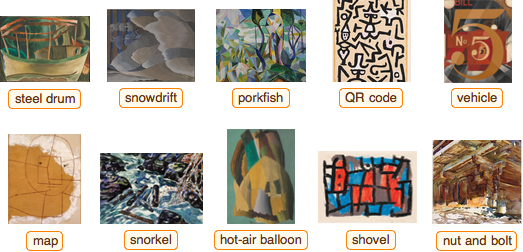
What the Wolfram Language does
Can help Wolfram Language? My goal in its creation was to build a bridge between the things that people want to do and what makes calculations possible. And if I did not create a language for humans, but for aliens — or even dolphins — one would expect it to be different.
In the end, it all comes down to calculations and the computational representation of everything. But the choice of what needs to be presented - and how it is presented - depends on the whole context. And even for people, these parameters change over time. For example, in the more than 30 years that I worked on the Wolfram Language, technology and the world have evolved significantly - as a result, there is a sense in adding many new things to the language. Promoting a cultural understanding of computation — things like hyperlinks and functional programming are becoming more common — also changes the concepts that can be used in the language.
So far, people have imagined the Wolfram Language as a way of communicating with computer users But I have always treated him as a computational language for general communication, both for people and for computers - it, among other things, allows people to think and communicate in computational terms. And, yes, the importance of computational thinking will increase - and the ability to think mathematically in the past will become more important.
But the key point is that Wolfram Language describes computation in terms accessible to humans. We can consider it as an attempt to define what parts of the universe of possible computations we, people, being at the current stage of civilization's development, consider most important.
Another way to say it in other words is to imagine the Wolfram Language as a way of compressed presentation (or model) of the essence of our civilization. Part of this entity is algorithmic and structured; part - data and knowledge about the details of the world and its history.
There is still a lot of work to be done to turn the Wolfram Language into a complete symbolic language for communication, capable of expressing the whole range of human intentions (for example, the ability to record fully legal contracts or ethical principles for AI). But with the Wolfram Language in its current form, we already cover a fairly large range of problems and achievements of our civilization.
But how to feed all this to the aliens? At some level, gigabytes of code and terabytes of data are just certain rules, like rules of cellular automata or any other computing systems. But the bottom line is that these rules were chosen to carry out calculations that seem to be the most important people.
This is a bit like the model of the Egyptian tombs, where you can see which classes the Egyptians considered important. If we give the alien Wolfram Language, we will give them a computational model of what we consider important. Apart from the fact that giving access to the whole language, instead of individual images or dioramas, we provide a much wider and deeper way of communication.
The reality of time capsules
What we are trying to do is in some sense reminiscent of
a time capsule . What lessons can we learn from the time capsules of the past? Unfortunately, the story does not particularly inspire us.
In particular, after the discovery
of Tutankhamen’s tomb in 1922, there was a surge of enthusiasm for the manufacture of time capsules, which lasted just over 50 years, leading to the creation — and usually burial — of the order of 10,000 time capsules. But most of these time capsules have already been
forgotten by now - mainly because the organizations that created them have changed activities or went bankrupt. In 1939,
those from Westinghouse , created specifically for the
world exhibition , became a proud example of creating a time capsule. Last year, the remnants of this company
filed for bankruptcy .
In my own mail archive over the past years, you can find a lot of requests for materials for time capsules, and looking at it, I remember that we created a time capsule for the 10th anniversary of the Mathematica system in 1998. But where is she now? I dont know. This is a typical problem. A maintained archive (library, etc.) can keep an eye on all things in an organized way, and time capsules turn out to be separate events, and often end up in secluded places, after which they are quickly lost and forgotten. The opposite may happen: people believe that there should be a time capsule in some place - for example, it was thought that John von Newman left such a capsule to be opened after 50 years - but it turns out that it is not.
One area in which at least informal versions of time capsules seem to work with some kind of periodicity is construction. For example, in England when repairing thatched roofs, about once every 50 years, messages from previous workers are often found. But especially the old tradition - the leading beginning even from the Babylonians - is the placement of messages in the foundations, in particular, in the corner stones of buildings.
Often at the time of Babylon, it could be an inscription that curses a person who demolishes a building to such an extent that its foundation can be seen. Later, other traditions emerged, for example, it was the custom of the
Freemasons to hide small commemorative boxes in the public buildings that they built.
Greater success than hidden time capsules, used the inscriptions on the stones in plain sight. And quite a large part of our knowledge of ancient history and culture really comes from such objects. Sometimes they are part of a larger, preserved architecture. But one of the
famous examples (the key to deciphering
cuneiform ) is a simple inscription scrawled on a rock located in the territory of modern Iran:

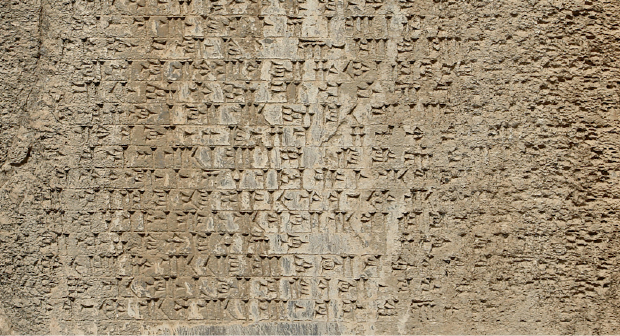
For expressiveness, a bas-relief with a life-sized image of warriors is added at the top.
The translated text begins as follows: “I am Darius the Great, King of Kings ...”, and then goes 76 paragraphs of achievements of Darius, many of which tell about suppressed revolts against him, in which the leaders of the uprisings had an inglorious end.
Such inscriptions are often found in the ancient world (as their more modest counterparts are often found today). But their irony is well conveyed by the sonnet Shelley “
Ozimandiyya ” (in honor of the Egyptian Ramses II), beloved by me as a child:
I met a traveler; he came from far away countries
And he said to me: in the distance, where eternity is stalking
Desert silence among the deep sands
A fragment of a broken statue lies.
From the half-erased features a haughty flame appears,
The desire to make the whole world serve itself;
Experienced sculptor put into a heartless stone
Those passions that could survive the centuries.
And saved the words of the fragment of the statue: -
“I am Ozimandia, I am a powerful king of kings!
Take a look at my great deeds,
Masters of all times, all countries and all seas! ”
There is nothing around ... Deep silence ...
The desert is dead ... And the skies above it ...
// translation by C. D. Balmont
If the “risks” section is in the description of the space beacon project, this description can be a good example.
Of course, in addition to the special "indicative" inscriptions, the ancient civilizations left many "documentary", preserved to this day in one form or another. Ten years ago I
bought via the Internet (yes, I am sure that it is real) a small tablet with a cuneiform, dated back to 2100 BC:

It turned out that this is a contract under which Mr. Lou-Nanna receives 1.5 gur (about 0.4 m
3 ) of barley in the summer month of
Damuzi (June-July), for which he must pay with certain goods in September-November.
Most of the surviving plates report something like this. One of the thousands tells about mathematics or astronomy. And looking at them today, it is interesting to see how far the Babylonians have advanced in mathematics and astronomy. But (with the exception of some astronomical parameters) after a certain moment we learn little from these tablets.
And this is a lesson for our current attempts. If we place mathematics or scientific facts in our lighthouses, this will show how far we have come (and, of course, to make the best impression, we need to include the most advanced research - for example, modern mathematics, but it will be quite difficult to do) . But this is a bit like job seekers who start their resume by describing basic facts. Yes, we all know this - tell us something about yourself!
But how best to do it? In the past, words had the greatest throughput. In today's world, this video - or AI-simulation. But this is not all, and this is evident in today's archeology. Almost any solid object carries microscopic traces of its history. Perhaps these are a few random molecules - DNA or something else that got into the kitchen utensils. Perhaps these are microscopic cracks and scratches of the material itself, showing wear.
Atomic microscopy is the beginning of one of their ways to systematically read such things. The field of introduction of molecular-scale computers such opportunities will grow faster and faster. This will give us access to a huge repository of “historical exhaust”.
We cannot immediately recognize the name "Lou Nann." But we can find out their DNA, the DNA of their scribe, at what time of the day the tablet was made, what smells and, perhaps, even the sounds were present when the clay dried. All this can be described as “sensory data” - and they, again, give us information about “what happened”, without any interpretation of what is considered important.
Messages in space
Okay, but our goal is to put information about our civilization in space. What is the history of previous attempts to do this? So far, there are only four spacecraft outside the solar system, and there are about a hundred devices in a more or less intact state on the surfaces of different planets (not counting the hard landings, the melted devices on Venus, and so on). In a sense, the spacecraft itself is a rather large “message”, an illustration of many technologies, and so on.

Probably the largest amount of “design information” will be contained in microprocessors.
- , , , , "
", 2006 ,
MIPS R3000 ( 12 ), 100 000 :

, ROM. , , , – ,
Voyager-1, which had not been used for the last 37 years, required deciphering the machine code for a long-disappeared bespoke CPU.The structure of the spacecraft can tell a lot about engineering and its history. Why does the antenna have such a shape ? It has a long history of origin from other antennas, which were produced and modeled so-and-so, and so on.What about more direct information about people? Often you can find small labels printed and fixed on the components of their manufacturers. Recently, there has been a tendency to send a list of people's names (more than 400,000 on “New Horizons”) in the form of engravings, microfilms or CD / DVD. Martian mission MAVEN carried 1000 , , 300 – DVD). « » :

. , -11 ( , 20°):

( "
" ) – , :

(
-2 ) , – , :

, – , «- » ( ?):

, – , -15. , :

. LEGO, «» ( : ,
):

– , 2018 , :

– . – ( ), -12:

«» ( ), "
-2 ":

« », , . « , » – 22 ; « , ».

, , « » – , , .
10 11, 1972 1973 ( ):

 I must say that I never liked this tablet. Its creators, in my opinion, outsmarted themselves. The biggest claim I have always had is the element on the left above. In the original article (under the leadership of Karl Sagan) about this tablet it is written that "this element should be immediately recognizable by physicists of other civilizations."But what is it? As a human physicist, I can guess: this is a canonical image of a neutral hydrogen radio line , also known as the 21 cm line. The arrows should represent the directions of the spins of the proton and the electron before and after the transition. But wait a minute: electrons and protons have a spin of 1/2, so they behave like spinors . And traditionally, in textbooks on quantum mechanics, spinors are often represented as vectors. But this is an arbitrary agreement.
I must say that I never liked this tablet. Its creators, in my opinion, outsmarted themselves. The biggest claim I have always had is the element on the left above. In the original article (under the leadership of Karl Sagan) about this tablet it is written that "this element should be immediately recognizable by physicists of other civilizations."But what is it? As a human physicist, I can guess: this is a canonical image of a neutral hydrogen radio line , also known as the 21 cm line. The arrows should represent the directions of the spins of the proton and the electron before and after the transition. But wait a minute: electrons and protons have a spin of 1/2, so they behave like spinors . And traditionally, in textbooks on quantum mechanics, spinors are often represented as vectors. But this is an arbitrary agreement., ? « », . , , . , . , , 21,106 , ( 22,9 )?!
, . , . ( ?) , .
, , - « IQ» , :

, , 1977 , . 12- "
«» " « »:

1977 « ». , ,
. «» ? , .
,
? 55 (
), 90- . , -, , , .
( ), .
116 , ( , ). – 1970-. – « », 2010 ( , 9 , S , , -):




, « » «», – :

, , ( 1990-) CD « »
-96 1996 ,
2012 – CD
Echostar 16 :

1976 LAGEOS-1, 8,4 . , « » . ( ?), 228- – - « ?»:

"
", , , - ,
, . , - , , .
, – . ( 5G ), ( ) . 50 60 ,
. .
1974-. ,
. . ? , ? ? , 8- ?

–
Doritos , the Beatles,
Craigslist , – .
, ,
. ? « »? , , . .
, , , , , . –
2000- ,
, "
– ", 10 000 ( « », ), , ,
WIPP .
1960 "
: ", «». , , « ». , , () .

, . "
Principia Mathematica " [. ], , 1910-. . , .
– . - , "
SETI ", 1999 ,
.
, . , , .
-, « », - , - . , «2001» 1:4:9 , , , , «».
, XIX , , , , , , « ». , , . , , .
, . , , , ( - ). , ( ), , .
, , , , « ». , , , , , .
- « » , , . , , – , ,
, , « ».
, «» « ». ? – – , , « » .
, , ( , ), . – , , , – , .
, . , – , , , ( , ..). , , - , , .
, , ? . .
, . , - – , :

, «»? ( , , ), . , - – – . , , .
, , . , . , , .
« ». , , , , , , .
, 10 000. , , , , . , , , .
. , , , – . , . , , .
. ? , ? ?
, – , , . , , , .
So how can you characterize a civilization and its cultural context? One may ask how it uses the computational universe of all possible programs. Which parts of this universe are important to it, and which parts are not?Perhaps the ultimate goal of cultural evolution is the use of the entire space of possible programs. Of course, our physical Universe is supposedly based on certain programs — although other programs can be perfectly emulated within the Universe., , , , «», « », - – , , – , . – , Wolfram Language (, , ) .
, , Wolfram Language, . , .
, . - , , , , , , , , , « » .
How can this be studied in practice? Of course, we can imagine what an analogue of the Wolfram Language language can be useful to the beings with whom we share the Earth. We can think about what seems useful for the AI - although there is a certain closed loop in this, since we are creating the AI for the fulfillment of human goals. But, perhaps, the best way to go ahead is to simply present some abstract listing of all possible Wolfram Language analogues, and then study possible translation methods between them.What should we send?
, . , , ?
. -, «», . , 2 + 2 = 4, , . , ( , ), . , : , , .
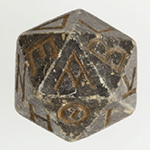
. , , , . – , .
, , : - , , – , . . , , , , .
- : , , .
But how to make it as efficient as possible? At least for the question of knowledge in general, I spent a lot of time on solving this problem. Since, in a sense, this is precisely the goal of Wolfram | Alpha: to create a system capable of calculating answers to the widest possible range of questions.So, yes, if we send Wolfram | Alpha, we will send the knowledge of our civilization in a concentrated, calculated form, ready for wide use.Of course, at least the public version of Wolfram | Alpha only works with general knowledge. What about more detailed information about people?, , , , . , , .
? , , : , -, , .
, « » . , . , , , , , .
, , ( ) ( !) , , – ( ).
? , . . , , , . , «».
«», – , . , . , , , , .
No matter what we send - biological or digital material - there are no guarantees of successful communication. Of course, our person or our AI will try to understand and respond to the requests of the stranger who has found them. But it can be a hopeless task. Yes, our representative may be able to identify the aliens, and observe their calculations. But this does not mean that there will be enough points of contact between him and the aliens so that at least something resembling some meaning can be conveyed.And it is definitely not encouraging that we have not yet been able to determine exactly what can be considered signs of the presence of alien intelligence in the Universe. It is also not encouraging that even on our planet we could not establish communication with other species., – – . . , - « ». , , . , , , .